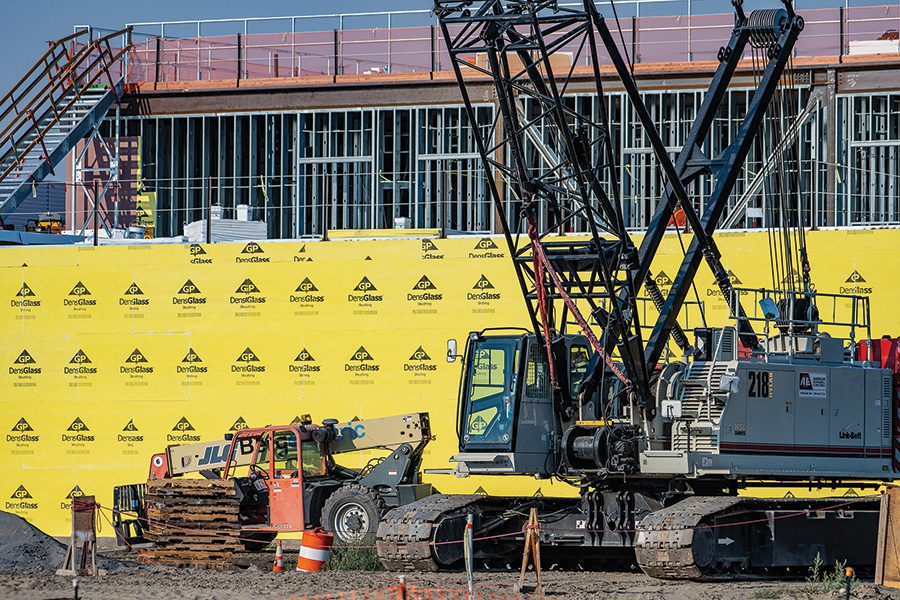
Home » Commercial Real Estate: Builders work to overcome market challenges
Commercial Real Estate: Builders work to overcome market challenges

October 17, 2022
In early September, amid a gloomy inflation report that sent financial markets plummeting, Darigold Inc. broke ground on a $600 million state-of-the art milk processing plant north of Pasco.
It is the largest project in the region, but hardly the only one. Even as builders struggle to hire qualified workers and manage rising costs, supply chain issues and worried clients, commercial construction is steaming ahead in the Tri-Cities. Private sector projects such as Darigold have overtaken government ones in headlines, but that could prove temporary.
State and federal infrastructure packages promise to spark public works across the country and the Richland and Pasco school districts will ask their voters to approve construction bonds to build new high schools and other facilities in early 2023.
The picture is one of continued growth in the Tri-Cities, tainted somewhat by economic jitters.
“It is a mixed bag,” said Joel Bouchey, regional director and public policy coordinator for the Inland Northwest chapter of Associated General Contractors of America. Nationally, AGC predicts rising prices and labor shortages could delay projects.
Staying optimistic
But Bouchey is an optimist who cites Darigold and a dizzying array of local projects that are keeping local contractors busy.
“As long as people stay optimistic, we’ll be fine,” he said.
Chervenell Construction, based in Kennewick, is one of the busiest commercial builders in the region with a hand in building a variety of projects, including the recent $10 million revamp of Fran Rish Stadium for the Richland School District.
Education is its bread and butter, but it keeps a hand in a variety of projects, working within a 120 miles of the Tri-Cities.
Fran Rish is finished, but Chervenell’s plate is full and it has enough work to keep it busy, said Brandon Mayfield, president. Its current roster includes the $31 million rebuild of Kennewick’s Ridge View Elementary, converting hotels in Pasco and Walla Walla into apartments and a new Goodwill store in College Place.
Mayfield is mindful of the challenges. Clients worry about rising costs and if the time is right to proceed. Tough conditions favor established firms such as Chervenell with their resources to tame the peaks, he said.
“In general, people who are looking to build have to understand where the market is and develop realistic budgets and expectations. As a general contractor, our job is to help with that process,” he said.
So far, he doesn’t see signs of a downturn.
“In real downturns, the bid opportunities disappear,” he said. “A lot of folks are worried that we’re driving toward a cliff. But I don’t think so for us locally.”
Locally, government-sponsored construction eased as most big budget projects wrap up and there’s a lull before new ones start.
The $17 billion Hanford Waste Treatment and Immobilization Plant, better known as the vitrification plant, is built and work is shifting to treating waste.
The Kennewick, Pasco and Richland school districts are wrapping up projects funded in their last rounds of voter-approved bonds.
Private sector
For now, the region is awash in private construction.
Two Amazon Inc. warehouses are nearly complete in east Pasco, as is a new food processing center for Reser’s Fine Foods.
In addition to Darigold, a private developer has proposed a warehouse park with 2 million square feet near Amazon. A mile or so away, Montana-based Local Bounti Inc. has resumed work to prepare its east Pasco site for a future greenhouse complex.
From Pasco to Prosser, builders are repositioning old hotels into micro apartments and constructing new apartments, strip malls and other facilities to accommodate the region’s growing population.
The public sector work has slowed, but not halted. President Joe Biden signed a $1 trillion infrastructure bill in late 2021. The 2022 Washington Legislature approved a $16.9 billion transportation package earlier this year.
Together, the spending bills could unleash a wave of public investment in civic infrastructure that only will swell if Pasco and Richland school district voters approve new bonds in 2023. Each wants to build a third high school and other educational facilities.
Government work
Cities and local government haven’t stopped building.

The city of Pasco advertised for bids to upgrade a water processing plant and to build a new fire station in September. It is also taking steps to build a new animal control facility. Prosser is replacing its old hospital and work continues on Pasco’s Lewis Street overpass, Kennewick’s Ridgeline Drive underpass, a new energy research facility at the Pacific Northwest National Laboratory in Richland and a new administrative office for Ben Franklin Transit.
Richland is extending Center Parkway across railroad tracks near Columbia Center to link Tapteal Drive in Richland with Gage Boulevard in Kennewick. Too, Richland is marketing its Horn Rapids area and preparing to ready City View near Queensgate for developers. Old Trapper, a Portland-area jerky manufacturer, plans to construct a processing plant in the city.
Also in Richland, the Port of Benton began work on a building that will form the heart of future STEM science tourism and serve as a home for the Hanford History Project. The Washington Military Department, having completed its $15 million Richland Readiness Center, now is making plans to construct a second edition of its Youth Academy on the same property in Horn Rapids.
Labor shortages
AGC fears contractors will struggle to complete projects because of supply chain issues and labor shortages, according to a summer survey conducted with AutoDesk. Participants identified labor shortages as a top issue.
According to the survey, 82% of firms say projects have been delayed because of supply chain issues and 66% said they have been delayed over labor shortages.
More than 90% cited hiring issues and more than 75% said finding qualified workers who could pass drug tests was a top challenge. In Washington state, 100% of the firms surveyed said they had job openings and were having trouble filling them.
“Construction workforce shortages are severe and having a significant impact on construction firms of all types, all sizes and all labor arrangements,” said Ken Simonson, AGC’s chief economist. “These workforce shortages are compounding the challenges firms are having with supply chain disruptions that are inflating the cost of construction materials and making delivery schedules and product availability uncertain.”
Construction jobs
The Tri-Cities isn’t spared the issues affecting other communities, but its heavy reliance on federal spending at the Hanford site coupled with robust food manufacturing helps isolate it.
“As you know we are quite unique in general,” said Ajsa Suljic, regional labor economist for the Washington Employment Security Department, which tracks job trends and unemployment claims.
Local construction employment stood at 11,400 in July, up 1,000 since 2019, the last year before the Covid-19 pandemic.
“We are running one of the highest construction numbers we have seen in Tri-City history. We have not seen that movement in construction jobs like that before,” she said.
Suljic said the actual number of people working in construction is far higher than the official numbers suggest. ESD counts workers covered by unemployment insurance. Self-employed workers who aren’t covered by unemployment insurance add another 50% to the total.
She credited residential construction for the increase rather than commercial. But it primed the pump for contractors, who hire based on word of mouth, she said.
“That’s how construction has operated. We don’t have training for all the trades. But most of the training is done for individuals who come in and work hard. So, the market is tight, but the friend-of-a-friend hiring approach is a strong propeller for employment. It’s similar to agriculture,” she said.
Bouchey, of AGC, said the labor shortage is a national, ongoing challenge that won’t be resolved until young adults see trades as viable careers. That said, general labor shortages have driven up wages, making it more attractive.
“We have fast food offering signing bonuses, so contractors have to adapt to that,” he said.
“Here, locally, we’ve added more jobs. But we have long-term needs.”
Construction + Real Estate
KEYWORDS october 2022





